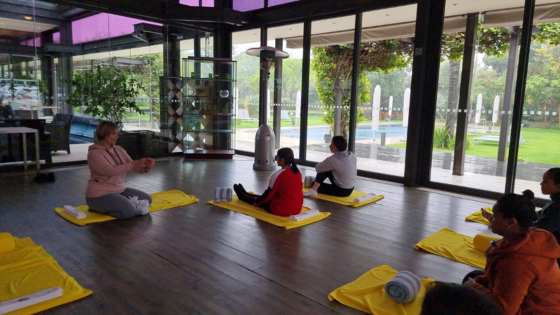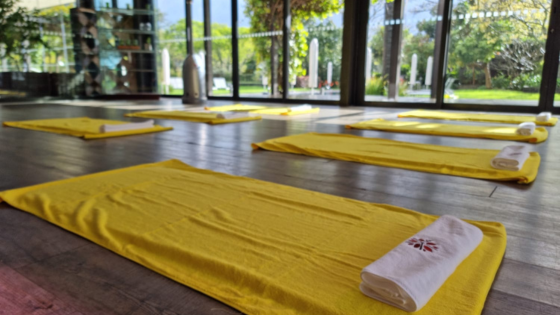What did you do to get back in shape after having your precious little bundle of joy? Did you do any postnatal yoga?
In this post, I’ll share my 3 favourite postnatal yoga exercises… the ones I wish I had started doing a couple of months after giving birth.
I have to be honest and say that all I did back then was breastfeed my baby, walk on the beach with him in a baby carrier, and practice a few kegel exercises from time to time.
It took me almost 10 years to get back into Yoga after having a baby because I told myself that I didn’t have the time or money to get out to a Yoga class.
My self-care was sorely lacking for the first few years of my child’s life as you may remember from my post about taking my health back.
And then, along came my wonderful friend, Adriana, who had been teaching Yoga and Pilates for years. A group of us had been swapping Access Bars sessions for a while when Adriana offered to teach us Yoga instead of swapping treatments one week.
After that one Yoga session (and lots of complaining from us girls), Adriana realised we needed to dial things back a bit and teach us the basics. Which reminds me…
Consult a Specialist First
If you have been diagnosed with diastasis recti or are suffering from pelvic organ prolapse or urinary incontinence after having a baby, I would recommend you get specialised help.
Firstly, a Medical Professional would have to have to approve you for exercise. It’s advisable to avoid any form of exercise, even Yoga or stretching, until after your 6-week postnatal check-up with your Doctor.
Be particularly gentle if you’ve had a C-section because of the internal scarring, and the fascia will have been shifted by the birthing experience.
And secondly, it would be wise to work with someone who specialises in helping women in their postpartum recovery. Someone like Simone Muller for example at re-centre.co.uk.
Simone is a former Ballet Dancer and has trained in Hypopressives, Pilates and Yoga, and focuses on postnatal rehabilitation.
See this video on how Hypopressives work.
My Favourite Postnatal Yoga Exercises
This brings me to my first favourite postnatal Yoga Exercise… if I had learned about this exercise earlier, this is the ONE postnatal yoga exercise I would have done in my first year as a Mom.
drumroll…
1. Diaphragmatic Breathing

In our next Yoga class, Adriana showed us how to do diaphragmatic breathing, also called deep belly breathing.
Why Diaphragmatic Breathing Helps Postpartum
Your diaphragm is attached to the bottom of the rib cage. Your ribcage shifts during pregnancy to make space for your growing baby. This is why you might experience shortness of breath during your pregnancy.
After birth, diaphragmatic breathing helps enormously to strengthen your deep core muscles and pelvic floor and stabilize your body.
Weak core muscles and pelvic floor muscles can lead to issues like urinary leakage and prolapsed bladders.
Slow, deep breathing allows your pelvic floor to relax fully so your muscles remain strong and flexible, while short, shallow breaths prevent your pelvic floor from fully relaxing.
Diaphragmatic Breathing is also very calming and is clinically proven to reduce stress and anxiety.
 How Diaphragmatic Breathing Works
How Diaphragmatic Breathing Works
In the photo above, Adriana is explaining how diaphragmatic breathing works.
When you breathe in, your diaphragm, expands and moves down, giving the pelvic floor a nice stretch.
When you breathe out, your diaphragm contracts and rises, gently contracting the pelvic floor.
Let’s visualize this for a moment. Imagine a balloon filled to the brim with air – it almost defies gravity and feels smooth and light.
Now, compare it to a deflated balloon – it’s just a dense piece of rubber that falls to the floor, thick and heavy.
When you practice diaphragmatic breathing, your body’s cells become like that fully inflated balloon – light, energized, and ready to take on the world.
How to Practice Diaphragmatic Breathing
Adriana taught us to lie on our tummies with a rolled-up towel beneath our diaphragm, first at the solar plexus.
Breathe deeply into that area, focusing on sending air down to the diaphragm and out fully, exhaling as much air as possible.
Breathe in for 4 counts, and out for 6 counts.
It sounds so simple, but it’s more strenuous to do than it looks.
What you want to do is breathe in deeply enough to feel the diaphragm expand and press into the towel. This can cause some discomfort.
If it causes pain, stop and flatten the towel a bit.
If you’re not feeling anything, roll the towel up tighter so the roll is a bit thicker.
Coming up on your elbows with your head up is generally easier than lying right down with your head on your hands. You can try both positions and feel what’s more comfortable and gives you the best core workout.
Then move the towel down to your belly button, to your hips, pelvis, and legs, while continuing to do a few minutes of breathwork at each zone.
Top Benefits of Diaphragmatic Breathing
- Helps you relax, reduces stress hormones
- Strengthens the diaphragm and pelvic floor muscles
- Improves stability in your core muscles
- Helps with pregnancy or new mom brain fog by improving concentration
- Decreases heart rate and reduces blood pressure
- Oxygenates your blood, bringing oxygen and nutrients to your digestive organs
- Increases energy and motivation
- Strengthens the immune system by helping remove toxins through the breath
2. Anterior Pelvic Tilts
Pelvic tilts need no explanation and are the next best exercise I would recommend for building your pelvic floor muscles and core.
Lie on your back with your hands next to your sides, knees bent and soles of your feet on the floor or yoga mat.
As you breathe out, gently rock your hips and raise your glutes slightly off the floor, pushing your lower back into the floor.
Stay up for a few counts and then lower gently, as you breathe in.
Repeat the tilt as many times as is comfortable for you (5 to 10).
3. Cat and Cow Pose
Kneel on the floor with your hands directly below your shoulder (shoulder distance apart) and your knees directly below your hips.
At rest, you will look like a four-legged animal like a dog or cat standing still.
Cat: Breathe out deeply, and drop your head, arching your back, like a cat having a good stretch.
Cow: Breathe in deeply and raise your head, curving your back.
Repeat slowly, 4 or 5 times.
Which Postnatal Yoga Exercises Are Your Favourite?
Now it’s over to you. I’d love to hear which postnatal yoga poses you used and how they helped you recover postpartum. Please leave a comment below.


This article eloquently highlights the numerous advantages of postnatal yoga, offering valuable insights for new mothers. Postnatal yoga provides a gentle yet effective approach to physical recovery, mental clarity, and emotional balance after childbirth. The emphasis on mindfulness and breathwork fosters resilience, while the sense of community in classes offers much-needed support. Practical tips for modifying poses and prioritizing self-care add a thoughtful touch. Overall, this article is a wonderful resource for postpartum women seeking to nurture their bodies and minds through the healing practice of yoga. How have you found postnatal yoga to benefit your postpartum journey?
Hi Chris, Thanks so much for adding such a thoughtful, in-depth response to this post.
I love that you added the benefit of support from the community in classes, I hadn’t thought to include that aspect in my post, yet I agree it’s one of my favourite benefits of any form of group exercise.
Having said that, I also love doing Yoga online, simply because it’s not easy to get out with a little baby (well, mine didn’t like going anywhere in a car until he was old enough to face forward).
It’s so convenient to do a Yoga lesson in the comfort of your own home, while the baby is sleeping next to you, and thanks to the internet and videos like Simone’s at Recentre, that’s possible.
If I’d known these were available back then, I’d have gotten back into Yoga a lot sooner and reaped the rewards.
For me, the biggest benefit of Yoga postpartum has been strengthening my core muscles again and improving muscle tone.
Hi, I have been searching for ideas to help my wife with this and came across this great article. We went through post-natal baby blues and she had always been fit and loved to exercise but following the birth of our first, this changed and much the same reasons you mention here were the same with her.
I will gently share these ideas with her as I know she wants to start up again, but I was hoping you may be able to give me some ideas to help her get motivated past those first couple of sessions. She is much happier with herself when active and I just want to help her get back to that.
Thanks in advance for your help.
Hi Ryan, aw, you sound like such a loving, caring husband. Thanks for your lovely comment.
I’m sorry to hear your wife went through the baby blues.
Exercise is an amazing anti-depressant, studies have proven it’s more effective than any drug on the market at alleviating depression – and with zero side effects.
Here’s what I recommend for motivation beyond the first few exercises. I did an awesome course recently called “The Science of Wellbeing” – it’s a course by Yale University and it’s free on Coursera (an online platform).
One of the things I loved about the course is that they are also using it as experiment, to see whether participants actually boost their happiness levels by doing the course.
Turns out, it does. I’m one of the happiest people I know, but even my happiness scores went up after completing the course.
When you agree to be part of the experiment you’re given access to an app where you track the actions you’re taking each day for what they call your “rewirements”.
And the app helps keep you accountable. I found that inputting my daily exercise on the app for a month kept me motivated.
It’s one of the main reasons I want to include an app when I launch my course on longevity. It takes 21 days to create a new habit, I’d like to help my participants create lasting change.
In the course, they also teach you something called the WOOP technique to improve motivation and there’s an app for WOOP too. You can download it free on Google Playstore.
Wishing your wife all the best as she gets back into exercise.